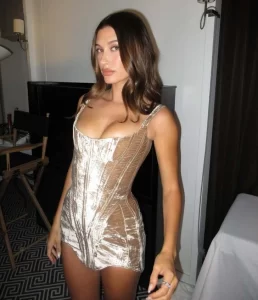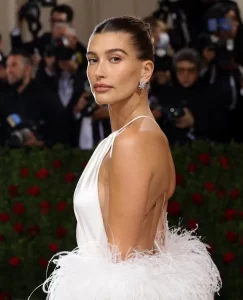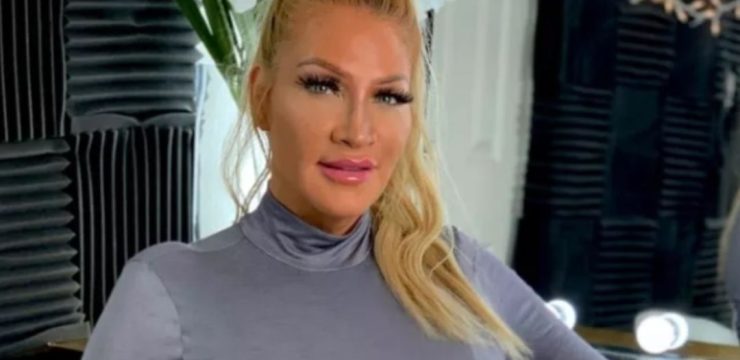Hailey Bieber is no stranger to capturing attention on the red carpet, and her appearance at the 2025 Met Gala was no exception. Known for her effortlessly polished style, she once again stepped into the spotlight with a sleek, minimalist look. Yet, despite the sophistication and signature elegance that accompanied her arrival, her fashion choice ignited a wave of mixed reactions online, leaving many fans and fashion enthusiasts debating whether her outfit truly embodied the bold theme of the evening.

Attending the prestigious event solo, Bieber arrived at the iconic Metropolitan Museum of Art wearing a black Saint Laurent blazer mini dress. The tailored garment hugged her figure with refined structure and simplicity, accentuated by sheer black tights that added a subtle touch of allure. To complete her ensemble, she opted for delicate Tiffany & Co. jewelry, which brought a hint of sparkle to her all-black ensemble. Her makeup was understated and fresh, and her hair was styled in a sleek, center-parted updo, reflecting her preference for classic sophistication.
While her outfit undoubtedly embodied Hailey’s signature modern chic aesthetic, it also raised a pressing question among fashion watchers and cultural commentators alike: did it align with the spirit of the Met Gala’s theme? The 2025 Met Gala had drawn inspiration from “Black dandyism” — an expressive and historically rich fashion movement defined by flamboyant colors, bold patterns, and daring silhouettes that reimagine elegance through the lens of Black cultural identity. This year’s theme called for extravagance, boundary-pushing creativity, and an embrace of the daring and dramatic.
Many felt Hailey’s outfit was too safe. Social media was soon flooded with a wave of critical responses that questioned her interpretation of the theme. One Instagram user commented, “Can’t believe you wore an everyday blazer,” while another posted, “Lazy. No inspiration. A waste of an invite on someone who clearly cares nothing about the exhibition.” The criticism didn’t stop there. Some fans voiced their disappointment more bluntly, stating, “We expected you to be the best dressed…what a disappointment.” Others questioned the basis for her invitation altogether, asking, “Why did you even go?” and “Why is she even invited? What does she do?”
These reactions reflected a broader sentiment among certain corners of the fashion world — a frustration with celebrities who, in their eyes, appear disconnected from the artistic and cultural significance behind the Met Gala themes. While the event has evolved into a major media spectacle, it remains rooted in its original purpose: to serve as a fundraiser for the museum’s Costume Institute and to celebrate fashion as an art form. Themes are carefully curated to honor diverse narratives and cultural histories, and attendees are expected to embrace these motifs with respect, imagination, and bold fashion choices.
In light of this, some critics argued that Hailey’s minimalist look, while undeniably elegant, lacked the interpretive depth and creativity that the occasion demanded. The blazer mini dress, though fashionable, was seen by some as an outfit better suited for a cocktail party or fashion week appearance rather than the Met Gala — an event known for dramatic couture, sculptural gowns, and avant-garde flair.
Yet, not all voices joined the chorus of criticism. Hailey’s supporters praised her for staying true to her aesthetic and highlighted her fashion consistency. They argued that not every look needed to be over-the-top to make an impact and that elegance and subtlety could speak volumes in an environment often dominated by visual excess. To these fans, Bieber’s outfit was a refreshing change — a masterclass in restraint that still delivered high fashion.
This clash of opinions has highlighted a growing tension in the world of celebrity fashion — the balance between personal style and thematic fidelity. For events like the Met Gala, which are steeped in cultural and historical nuance, this balance is especially important. When attendees ignore or underplay the theme, it can be interpreted as a disregard for the deeper meaning behind the celebration. However, when they adhere too rigidly, there’s a risk of costumes feeling forced or theatrical.
Bieber’s choice, in many ways, embodied this tension. It was stylish, yes. Sophisticated? Certainly. But was it thematic? That remains a point of debate. This controversy has reignited discussions about what it means to truly engage with the Met Gala’s themes — not just as a surface-level dress code, but as a form of cultural participation. For many, the night is not just about looking good — it’s about making a statement, paying tribute to the artists and communities that inspire the theme, and using fashion as a storytelling medium.

It’s also worth noting that Hailey wasn’t the only one under scrutiny that night. Anna Wintour, the legendary editor-in-chief of Vogue and the unofficial queen of the Met Gala, arrived in a stunning ensemble that initially appeared flawless. However, eagle-eyed fans quickly spotted a tiny wardrobe flaw — an unexpected detail that sparked a flurry of online chatter. Though minor, this moment reminded audiences that even fashion royalty can have off moments, humanizing the event’s usually untouchable icons.
Meanwhile, Demi Moore surprised attendees with a delightful twist of her own. Her ensemble, rich in color and texture, was considered one of the most on-theme of the evening. She paired it with a playful accessory that paid homage to the theme’s roots while showcasing her personality — a creative gesture that earned her widespread praise. In doing so, Moore demonstrated how stars could blend individuality with cultural awareness, resulting in an outfit that both wowed and respected the theme’s intent.
As the dust settles on another year of Met Gala fashion, Hailey Bieber’s look continues to stir debate. Was it a fashion misstep or an example of quiet sophistication misunderstood by the masses? Depending on whom you ask, the answer might differ. But what’s certain is that her presence — and the reactions it provoked — have sparked meaningful conversations about the role of fashion at cultural events, the expectations placed on celebrities, and the ongoing challenge of honoring art through personal expression.
Fashion, after all, is inherently subjective. One person’s daring masterpiece may be another’s over-the-top mess, just as one’s minimalist chic can be another’s missed opportunity. And in an event as globally visible and historically significant as the Met Gala, every detail matters — from the fabric and cut to the story a look is meant to tell. Hailey Bieber’s appearance may not have satisfied everyone’s expectations, but it undeniably added to the fabric of the event, making her one of the most talked-about attendees of the night.
In the end, the conversation itself is a testament to the power of fashion. Whether through celebration or critique, it inspires dialogue, evokes emotion, and challenges perceptions. For better or worse, Hailey Bieber succeeded in doing just that. And for an event rooted in the celebration of fashion’s power to move, provoke, and inspire, that may be the greatest impact of all.





